Type S class Scout/Courier
| Type S class Scout/Courier | |
|---|---|
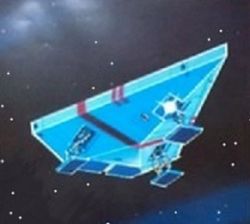 A view of a Type S coming in for a landing. | |
| Type: SC Scout/Courier | |
| Category | ACS |
| Size | 100 Tons |
| Hull Configuration | Wedge Hull |
| Streamlining | Lifting Body Hull |
| Tech Level | TL–12 |
| Engineering | |
| Computer | Model/1 bis |
| Jump | J-2 |
| Maneuver | 2 G |
| Armaments | |
| Hardpoints | 1 |
| Accommodations | |
| Staterooms | 0 |
| Personnel | |
| Crew | 1 |
| Officers | 1 |
| High/Mid Passengers | 0 |
| Payload | |
| Cargo | 3.0 Tons |
| Fuel tank | 0 Tons |
| Construction | |
| Origin | Third Imperium |
| Year Operational | X |
| End of Service | Still in active service. |
| Price | |
| Cost | MCr29.43 |
| Architect fee | MCrMarc Miller (design) & Dave Sering (image) |
| Statistics | |
| Quick Ship Profile | SC-AL22 |
| Images | |
| Blueprint | Yes (multiple) |
| Illustration | Yes |
| Source | |
| Also see | Scout Vessel - Scout/Courier |
| Canon | Published, fan design |
| Era | 1105 |
| Reference | Characters and Combat 24-25. |
Starships are designed with the Classic Traveller format, using High Guard.
| |
Scout/Courier (type S): Using a 100-ton hull, the scout/courier is intended for exploration, survey, and courier duties, with many in service throughout known space. [1]
- It is a 100-ton dispatch vessel of a type very common within human space. [2]
- It is an ubiquitous starship found within Charted Space. Many variant classes exist of this type.
- Its QSP is S-AL22.
- Most scouts are paramilitary ships and Scout/Couriers.
Basic Ship Synopsis
S Scout. 100 tons. Jump-2. 2-G. 40 tons fuel. Model/1 bis. 4 staterooms. 1 hardpoint (double turret). Air/raft. 3 tons cargo. Streamlined. 1 crew. MCr29.43; 9 months. [3]
Description (Specifications)
Scout/Courier (Type S): Using the type 100 hull, the scout/courier is equipped with four staterooms (…allowing a total of eight passengers and crew if double occupancy is assumed), but there are no low berths. The crew consists of a pilot who also doubles as navigator, engineer, and gunner; additional crew members to fill these slots may be hired on as desired. The ship has jump drive-A, maneuver drive-A, and power plant-A, producing a performance of Jump-2 and 2-G acceleration. The bridge has a computer Model/1 bis (…with a standard software package) and one ton of fire control space allocated to the ship's single hardpoint. The ship is fitted with a dual turret; the weaponry installed varies with the specific ship. The ship has a specially fitted hold which carries a single air/raft; there is a separate three-ton cargo hold. The hull is streamlined for atmospheric landings, and fuel scoops allow local refuelling from oceans or gas giants. [4]
It mounts jump drive-A, maneuver drive-A, and power plant-A, giving performance of Jump-2 and 2-G acceleration. A 40-ton fuel tank provides fuel for the power plant and provides sufficient fuel for one Jump-2. Adjacent to its bridge is a computer Model/1 bis. There are four staterooms and no low berths. One double turret with its fire control is installed on the ship's hardpoint, but no weaponry is mounted. One air/raft is carried in a specially fitted hangar within the ship. Cargo capacity amounts to 3 tons. The hull is streamlined. The scout/courier requires a crew of one, assuming the duties of pilot and engineer. The ship costs MCr 29.43 and typically takes nine months to build. [5]
Image Repository
- A very early model Type S made by MC&S Engineering.
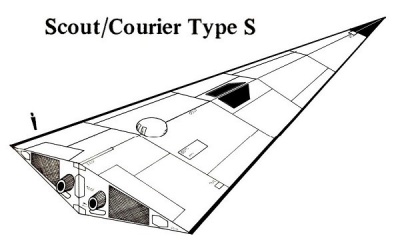
- A sketch of a Type S class Scout/Courier by a famous starship artist.

- A typical Type S class Scout/Courier scout ship preparing to enter jumpspace.
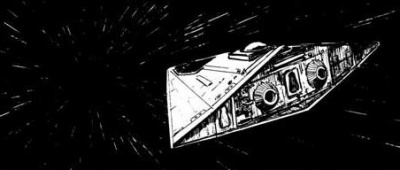
- A very modern model, the Gibson class Scout/Courier.
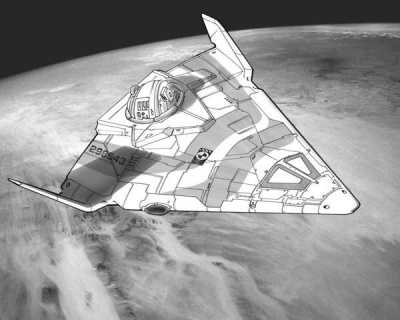
- A classic, long serving Sulieman class Scout/Courier.
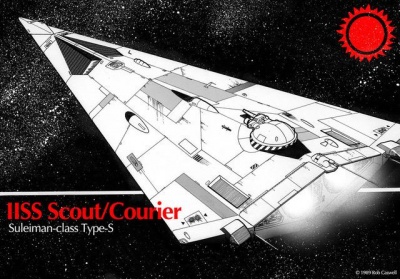
- The Hunter class Armored Scout, a cheap Solomani knock-off of the Type S.

- A Sulieman class Scout/Courier under spaceflight orbiting a yellow star.
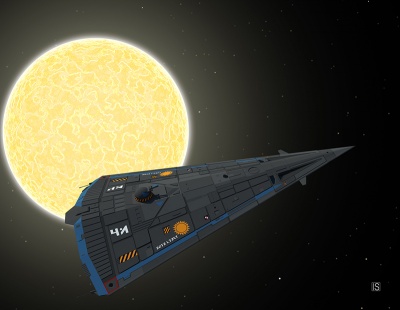
- A Type-S in front of a nebula.
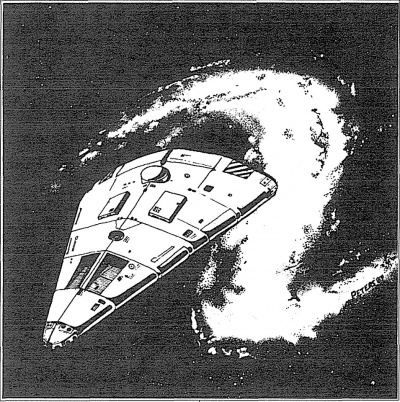
- A Type-S in front of a different nebula.
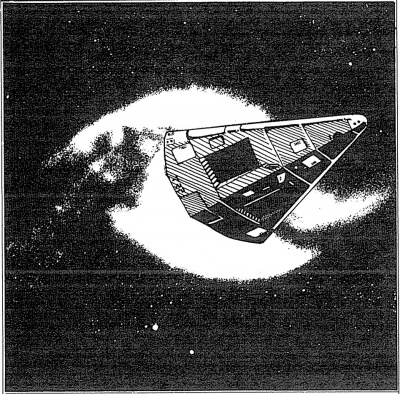
- A Type-S exploring an anomaly-nebula.
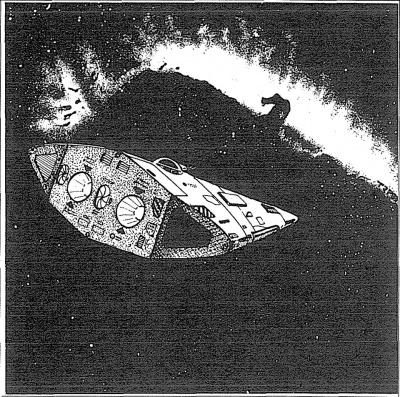
General Description & Deck Plans
- Deck Plans for an older model Type S class Scout/Courier.

Basic Ship Characteristics
Following the Imperial Navy and IISS Universal Ship Profile and data, additional information is presented in the format shown here. The small craft factor indicates the number of squadrons (...of ten craft) carried on the ship. Tonnage on the universal ship profile is shown in kilotons (...thousands of tons) where necessary. [6]
| #. | Category | Remarks |
|---|---|---|
| 1. | Tonnage / Hull | 100 tons. The hull is streamlined. [8] |
| 2. | Crew | The scout/courier requires a crew of one, assuming the duties of pilot and engineer. [11] |
| 3. | Performance | It mounts jump drive-A, maneuver drive-A, and power plant-A, giving performance of jump-2 and 2-G acceleration. A 40-ton fuel tank provides fuel for the power plant and provides sufficient fuel for one Jump-2. [13]
|
| 4. | Electronics | Adjacent to its bridge is a Model/1 bis ship computer. [16] |
| 5. | Hardpoints | x1 hardpoint. |
| 6. | Armament | x1 Double turret with its fire control is installed on the ship's hardpoint, but no weaponry is mounted. [17]
|
| 7. | Defenses | When the turret is filled with weaponry, a sandcaster is typically fitted. |
| 8. | Craft | x1 Air/raft is carried in a specially fitted hangar within the ship. [19] |
| 9. | Fuel Treatment | It is typically equipped with purification and fuel scoops. |
| 10. | Cost | The ship costs MCr 29.43. [21] |
| 11. | Construction Time | It typically takes nine months to build. [23] |
| 12. | Comments | Cargo: Three tons. [24]
|
Ship Weaponry
Weaponry: The actual weaponry carried on the scout/courier varies with the mission accorded the ship.
- Couriers generally mount a single laser and a single missile rack.
- Exploratory scouts mount two missile racks.
- Detached duty scout/ couriers are provided without weaponry, but the crew generally acquires some sort of firepower in a short time. [26]
Ship Interior Details
Interior Details: The deck plan indicates the interior layout for the typical scout/courier. The staterooms (4, 5, 6, and 7) are large and spacious, an essential consideration when the crew may be forced to spend long hours together. The common area (8) contains recreation equipment, a galley, and eating facilities. The rear section (13) serves many purposes; on scouts, it carries laboratory and sensor equipment; on couriers, it carries communication equipment and data banks; on detached duty ships, it is cleared out and become a lounge for the crew. The forward cargo compartment (20) carries three tons of cargo, and is accessible from just behind the bridge, or from outside. The upper gallery contains the gunnery position (16), a storage area (18) much like an attic, and a forward sensor position (19). The void spaces within the hull (9) contain fuel, pumps, and other equipment. Two specific areas (10) contain the landing feet for the ship, including retraction equipment. [27]
Ship Costs
Costs: A new type S scout/courier, direct from the builder, costs MCr27.63. Using a standard financing arrangement, a down payment of MCr5.53 would be made, with monthly payments of Cr132,600 for 480 months following. Surplus scout/couriers can generally be had for MCr15 to MCr18, but those prices are for cash, and financing is difficult to obtain for such used vessels. [28]
History & Background (Dossier)
The venerable Type S is one of the smallest ships to mount a jump drive and is used in nearly every capacity imaginable from civilian, to paramilitary to military uses. They are relatively easy to find used and the basic hull is near endlessly modifiable. [29]
Scout Ship Overview
THE SCOUT/COURIER: One of the most common starships within the Third Imperium is the tested and tried type S scout/courier. Originally produced to specification for the Imperial Interstellar Scout Service, this sleek and simple ship was intended for common courier duties within the Imperium, and simple survey and exploration duties beyond the Imperial borders. [30]
While the xboat system provides fast forwarding of messages and information along the major xboat routes within the Imperium, it falls to the Scout Service's fleet of scout/couriers to relay information from worlds along the routes to outlying fringe worlds. The Jump-2 capability of the scout/courier places nearly all such worlds within its range. [31]
Beyond the Imperial borders (…and in relatively unexplored regions within the Imperium) the scout/courier is pressed into service as an exploratory vessel. It can roam through most areas, refuelling itself from gas giants or planetary oceans as necessary, checking up on local conditions, and filing reports when it returns from a mission. In some areas, an Exploratory Cruiser of perhaps 10,000 tons will carry a squadron of ten or more scout/couriers. As the cruiser passes through an area, individual scout/couriers will range ahead or to the flanks and perform actual data gathering missions. [32]
IISS Reserve Scout Ship Policy
It is the policy of the scout service to make available such surplus scout ships to selected individuals on a reserve basis. The vessels are (hopefully) put to good use while they are not required in service, and both the ship and its pilot are available for recall to duty when needed. Possession of the scout ship is at the pleasure of the scout service, and it cannot be sold by the character. Fuel is free at scout bases. Maintenance is free at the scout bases at class B starports. The traveller is responsible for both upkeep and crew costs. [33]
Because the scout/courier is a standard design, the Scout Service has a large quantity of the vessels on hand, with the natural result that some are sold at surplus and find their ways into private or commercial hands, while others are scrapped. In addition, however, many are diverted to a scout program called detached duty. Under the direction of the Scout Service's Detached Duty Office, some former or retired scout personnel are provided with scout/couriers for their own use. The ships are too small for profitable commercial operations, but they do serve as a form of reasonable transport for those with wanderlust. In addition, the Scout Service derives a reasonable intelligence return on its investment through the examination of the ships' logbooks when they are serviced, and through routine interrogation and debriefings of crews. Finally, such detached duty scout/couriers are subject to recall and activation (with crew) in the event of a war scare or mobilization alert. [34]
Class Naming Practice/s & Peculariarities
Peculiarities: The major fault of the type S scout/courier is its air system. Although of respectable quality for life support, it begins to smell after about three weeks of use. Thereafter, the smell becomes increasingly obnoxious, and most crew members find the smell intolerable after six weeks. The problem can be corrected by flushing the air system, which operation costs Cr1,000 for parts and components. Temporary respite may be obtained (for about a week) by replacing the system's air filters (...at Cr200). Both these processes also require a plentiful supply of breathable air. Instead, the entire air system may be replaced with a better model; it costs Cr70,000 and requires sacrificing one ton of cargo space. [35]
Selected Variant Types & Classes
Paramilitary Vessel - Scout/Courier:
Paramilitary Vessel - Bounty Hunter:
Civilian Vessel - Medical Vessel:
Civilian Vessel - Prospector Vessel:
References & Contributors (Sources)
| This article has metadata. |
- Marc Miller. Characters and Combat (Game Designers Workshop, 1977), 24-25.
- Marc Miller. Starships (Game Designers Workshop, 1977), 19.
- Dave Sering. Starships and Spacecraft (Judges Guild, 1979), TBD.
- Marc Miller. Traders and Gunboats (Game Designers Workshop, 1980), TBD.
- Timothy B. Brown. Fighting Ships (Game Designers Workshop, 1981), TBD. (Classic Traveller Supplement 9)
- Marc Miller. High Passage 5 (FASA, 1982), TBD.
- Marc Miller. Starter Traveller (Game Designers Workshop, 1983), 11.
- Frank Chadwick, Dave Nilsen. "Technical Booklet." Brilliant Lances (1994): 19.
- Martin Dougherty. Scout Ships (Avenger Enterprises, 2007), TBD.
- Martin Dougherty. Type S (ComStar Games, 2008), TBD.
- Signs & Portents 66 The Type-S Scout Deckplan (Review) by Bryan Steele March 2009
- Citation Missing - Type S Scout/Courier
- Marc Miller. T5 Core Rules (Far Future Enterprises, 2013), TBD.
- Marc Miller. Starships and Spacecraft (Far Future Enterprises, 2014), TBD.
- Martin Dougherty. Type-S Scout/Courier (Mongoose Publishing, 2015), TBD.
- Citation Missing - Type S Scout/Courier
- Traveller Wiki Editorial Team
- Author & Contributor: FarScout275
- Author & Contributor: Lord (Marquis) and Master of Sophontology Maksim-Smelchak of the Ministry of Science
- ↑ Marc Miller. Starships (Game Designers Workshop, 1977), 19.
- ↑ Marc Miller. Characters and Combat (Game Designers Workshop, 1977), 25.
- ↑ Marc Miller. Starter Traveller (Game Designers Workshop, 1983), 11.
- ↑ Marc Miller. Traders and Gunboats (Game Designers Workshop, 1980), 15-16.
- ↑ Marc Miller. Starships (Game Designers Workshop, 1977), 19.
- ↑ Timothy B. Brown. Fighting Ships (Game Designers Workshop, 1981), 10.
- ↑ Timothy B. Brown. Fighting Ships (Game Designers Workshop, 1981), 10.
- ↑ Marc Miller. Starships (Game Designers Workshop, 1977), 19.
- ↑ Marc Miller. Traders and Gunboats (Game Designers Workshop, 1980), 17.
- ↑ Marc Miller. Traders and Gunboats (Game Designers Workshop, 1980), 17.
- ↑ Marc Miller. Starships (Game Designers Workshop, 1977), 19.
- ↑ Marc Miller. Traders and Gunboats (Game Designers Workshop, 1980), 17.
- ↑ Marc Miller. Starships (Game Designers Workshop, 1977), 19.
- ↑ Marc Miller. Traders and Gunboats (Game Designers Workshop, 1980), 17.
- ↑ Marc Miller. Traders and Gunboats (Game Designers Workshop, 1980), 16.
- ↑ Marc Miller. Starships (Game Designers Workshop, 1977), 19.
- ↑ Marc Miller. Starships (Game Designers Workshop, 1977), 19.
- ↑ Marc Miller. Traders and Gunboats (Game Designers Workshop, 1980), 17.
- ↑ Marc Miller. Starships (Game Designers Workshop, 1977), 19.
- ↑ Marc Miller. Traders and Gunboats (Game Designers Workshop, 1980), 17.
- ↑ Marc Miller. Starships (Game Designers Workshop, 1977), 19.
- ↑ Marc Miller. Traders and Gunboats (Game Designers Workshop, 1980), 16.
- ↑ Marc Miller. Starships (Game Designers Workshop, 1977), 19.
- ↑ Marc Miller. Traders and Gunboats (Game Designers Workshop, 1980), 17.
- ↑ Marc Miller. Starships (Game Designers Workshop, 1977), 19.
- ↑ Marc Miller. Traders and Gunboats (Game Designers Workshop, 1980), 16.
- ↑ Marc Miller. Traders and Gunboats (Game Designers Workshop, 1980), 16.
- ↑ Marc Miller. Traders and Gunboats (Game Designers Workshop, 1980), 16.
- ↑ Information provided to the library by Maksim-Smelchak
- ↑ Marc Miller. Traders and Gunboats (Game Designers Workshop, 1980), 15.
- ↑ Marc Miller. Traders and Gunboats (Game Designers Workshop, 1980), 15.
- ↑ Marc Miller. Traders and Gunboats (Game Designers Workshop, 1980), 15.
- ↑ Marc Miller. Characters and Combat (Game Designers Workshop, 1977), 25.
- ↑ Marc Miller. Traders and Gunboats (Game Designers Workshop, 1980), 15.
- ↑ Marc Miller. Traders and Gunboats (Game Designers Workshop, 1980), 16.